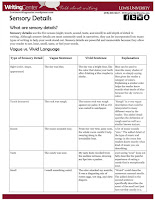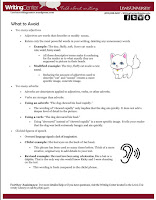Writing for the Senses: How to Use Imagery to Transport Readers
By Olivia Salter
Imagery is a powerful tool in fiction writing. It allows you to create vivid, sensory-rich scenes that immerse readers in your story. By appealing to their senses—sight, smell, touch, taste, and sound—you can transport them to different worlds, evoke emotions, and make your narrative unforgettable. In this article, we’ll explore how to effectively use imagery to engage readers’ senses.
1. Sight
Visual imagery paints pictures in readers’ minds. To enhance this sense:
- Show, don’t tell: Instead of saying “The room was messy,” describe the cluttered desk, the crumpled papers, and the dust motes dancing in the sunlight.
- Use similes and metaphors: Compare objects to familiar things. For example, “Her eyes were as blue as the ocean.”
- Example:
Sight:
- Before
her stood a crumbling mansion, its once-grand facade now weathered and
gray. Ivy clung to the walls like a forgotten memory.
- The
sun dipped below the horizon, casting long shadows across the deserted
alley. Broken glass glittered like diamonds underfoot.
2. Smell
Olfactory imagery evokes memories and emotions. To engage readers’ sense of smell:
- Be specific: Describe scents in detail. Is it the aroma of freshly baked bread or the acrid stench of burnt rubber?
- Associate smells with emotions: The scent of pine needles might remind a character of childhood Christmases.
- Example:
Smell:
- The
bakery’s door swung open, releasing a cloud of warm cinnamon and vanilla.
It wrapped around her like a comforting hug.
- The
salty tang of the sea hung in the air, promising adventure and salty
kisses.
3. Touch
Tactile imagery allows readers to feel textures and sensations. To create a tactile experience:
- Texture matters: Is the velvet sofa soft or scratchy? Is the rain cold or refreshing?
- Physical sensations: Describe the warmth of a hug, the roughness of tree bark, or the chill of a winter breeze.
- Example:
Touch:
- His
fingers brushed against the rough bark of the ancient oak tree. Each
groove told a story of storms weathered and secrets shared.
- The
silk sheets slid against her skin, cool and inviting, as she settled into
bed.
4. Taste
Gustatory imagery brings flavors to life. To tantalize readers’ taste buds:
- Be specific: Don’t just say “The soup was delicious.” Describe the savory broth, the hint of garlic, and the warmth spreading through their mouth.
- Link taste to memories: Maybe the taste of apple pie transports a character back to their grandmother’s kitchen.
- Example:
Taste:
- The
first bite of the ripe peach exploded with sweetness, juice dribbling
down her chin. Summer had never tasted so good.
- The
bitter coffee clung to his tongue, a familiar ritual that anchored him to
reality.
5. Sound
Auditory imagery immerses readers in the auditory world. To evoke sound:
- Choose words carefully: Use onomatopoeia (words that sound like what they represent) or rhythmic language. For instance, “The waves crashed against the shore.”
- Capture ambient sounds: The distant hum of traffic, the chirping of birds, or the creaking floorboards—all contribute to the atmosphere.
- Example:
Sound:
- The
distant rumble of thunder echoed through the valley, promising rain.
Leaves rustled, whispering secrets.
- The
violinist’s bow danced across the strings, filling the concert hall with
haunting melodies.
Using Imagery in Dialogue: Bringing Conversations to Life
Incorporating vivid imagery into dialogue can elevate your characters’
interactions, making them more engaging and memorable. Here are some techniques
to enhance dialogue with sensory details:
1.
Descriptive Language:
- Show,
Don’t Tell:
Instead of straightforward statements, use descriptive language to convey
emotions and sensations. For instance:
- Telling: “It’s raining
heavily.”
- Showing: “The rain drummed on
the rooftop, drowning out our conversation.”
- Character
Reactions:
Describe how characters physically react to their surroundings. For
example:
- “The
acrid smoke stung my eyes,” or “His
fingers traced the rough edge of the ancient map.”
2.
Setting the Scene:
- Use dialogue to immerse
readers in the environment. Mention sounds, smells, and textures:
- “The
salty breeze carried the scent of the ocean,” or “The café hummed with the clatter of
dishes.”
3.
Metaphors and Similes:
- Characters can use
metaphors and similes during conversations:
- “Her
laughter bubbled like a mountain stream,” or “His voice was as smooth as polished
marble.”
4.
Emotional Impact:
- Connect sensory
experiences to emotions:
- “The
taste of warm apple pie reminded me of Grandma’s kitchen,” or “The icy wind mirrored my loneliness.”
Keep in mind, dialogue isn’t just about words—it’s about creating a multisensory
experience for readers. By weaving imagery into conversations, you’ll transport
them deeper into your fictional world.
In conclusion, by skillfully incorporating sensory details, you can make your writing come alive. Whether it’s the scent of a blooming flower, the crunch of autumn leaves underfoot, the taste of salt on the sea breeze, or, the scent of a loved one’s perfume, these vivid images will transport your readers into your fictional world. Imagery will stay with readers beyond the page. So, next time you write, engage all their senses and create a world they won’t want to leave. The key is to be specific and evoke emotions through sensory
details.
Remember, the magic lies in the details—the sights, smells, tastes, touches, and sounds that linger long after the book is closed.
Also see:






